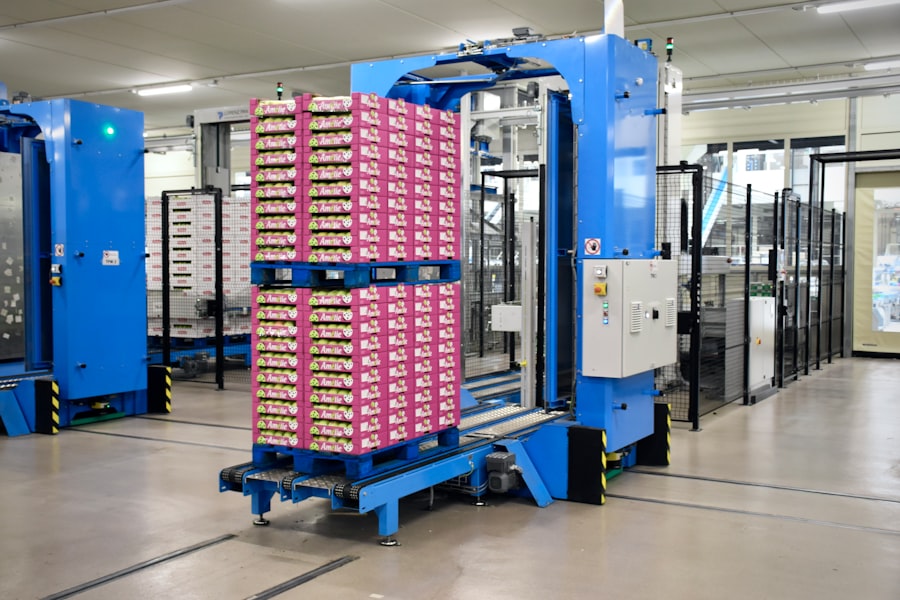Streamlining workflows is essential for organizations seeking to enhance efficiency, reduce costs, and boost productivity. By optimizing processes and eliminating unnecessary steps, businesses can conserve time and resources, enabling employees to concentrate on higher-value tasks. This approach not only improves employee satisfaction but also enhances the overall customer experience.
Streamlined workflows contribute to error reduction and increased accuracy, leading to improved decision-making and better business outcomes. In today’s rapidly evolving and competitive business environment, organizations must be agile and responsive to market changes. Streamlined workflows allow businesses to adapt swiftly to shifting market demands and customer needs.
This approach also facilitates improved collaboration and communication among teams, fostering enhanced teamwork and innovation. Ultimately, streamlining workflows is crucial for organizations to maintain competitiveness and thrive in the modern business landscape. The benefits of streamlined workflows extend beyond internal operations.
By optimizing processes, businesses can respond more effectively to customer inquiries, deliver products and services more efficiently, and maintain a competitive edge in their respective markets. Additionally, streamlined workflows can lead to reduced operational costs, improved resource allocation, and increased overall organizational effectiveness. As technology continues to advance, organizations have access to various tools and software solutions designed to facilitate workflow streamlining.
These may include project management platforms, automation tools, and data analytics software, which can further enhance the efficiency and effectiveness of streamlined processes.
Key Takeaways
- Streamlining workflows is crucial for improving efficiency and productivity in any organization.
- AI can be leveraged to automate repetitive tasks and streamline workflows, freeing up time for more strategic work.
- Identifying opportunities for automation in workflows is essential for maximizing the benefits of AI and automation tools.
- Implementing AI and automation tools in workflows requires careful planning and consideration of the specific needs of the organization.
- Overcoming challenges in streamlining workflows with AI and automation requires a combination of technological solutions and change management strategies.
Leveraging AI for Workflow Automation
Improved Efficiency and Productivity
AI-powered workflow automation can significantly improve efficiency by reducing manual intervention and human error. By leveraging AI, organizations can automate routine tasks such as data entry, document processing, and customer support, freeing up employees to focus on more strategic and creative work.
Enhanced Data Analysis and Decision-Making
AI can also analyze large volumes of data at a speed and scale that is impossible for humans, leading to better insights and decision-making. This can be particularly beneficial in industries such as finance, healthcare, and manufacturing, where data analysis is critical for business success. Additionally, AI can learn from historical data and continuously improve its performance, leading to more accurate predictions and recommendations.
Personalized Customer Experience and Business Growth
Furthermore, AI-powered workflow automation can enhance the overall customer experience by enabling personalized interactions and faster response times. This can lead to increased customer satisfaction and loyalty, ultimately driving business growth. Overall, leveraging AI for workflow automation can lead to significant cost savings, improved productivity, and better business outcomes.
Identifying Opportunities for Automation in Workflows

Identifying opportunities for automation in workflows is a critical step in streamlining processes and improving efficiency. Organizations should start by analyzing their existing workflows to identify repetitive tasks that are time-consuming and prone to errors. These tasks are prime candidates for automation as they can free up valuable time for employees to focus on more strategic activities.
Another opportunity for automation lies in the integration of disparate systems and applications. Many organizations use multiple software tools for different functions such as customer relationship management (CRM), accounting, and project management. Integrating these systems through automation can streamline data flow and eliminate the need for manual data entry or reconciliation.
Furthermore, organizations should look for opportunities to automate decision-making processes using AI algorithms. For example, in the finance industry, AI can be used to automate credit scoring or fraud detection processes, leading to faster and more accurate decisions. By identifying these opportunities for automation, organizations can significantly improve efficiency and reduce operational costs.
Identifying opportunities for automation in workflows is a critical step in streamlining processes and improving efficiency. Organizations should start by analyzing their existing workflows to identify repetitive tasks that are time-consuming and prone to errors. These tasks are prime candidates for automation as they can free up valuable time for employees to focus on more strategic activities.
Another opportunity for automation lies in the integration of disparate systems and applications. Many organizations use multiple software tools for different functions such as customer relationship management (CRM), accounting, and project management. Integrating these systems through automation can streamline data flow and eliminate the need for manual data entry or reconciliation.
Furthermore, organizations should look for opportunities to automate decision-making processes using AI algorithms. For example, in the finance industry, AI can be used to automate credit scoring or fraud detection processes, leading to faster and more accurate decisions. By identifying these opportunities for automation, organizations can significantly improve efficiency and reduce operational costs.
Implementing AI and Automation Tools in Workflows
Implementing AI and automation tools in workflows requires careful planning and execution to ensure successful integration into existing processes. Organizations should start by defining clear objectives for automation and identifying the specific tasks or processes that will be automated. This will help in setting realistic expectations and measuring the impact of automation on key performance indicators.
Next, organizations should evaluate different AI and automation tools available in the market to find the best fit for their specific needs. It’s important to consider factors such as ease of integration with existing systems, scalability, security features, and vendor support. Once the right tools are selected, organizations should develop a detailed implementation plan that includes training employees on how to use the new tools effectively.
Furthermore, organizations should continuously monitor the performance of AI and automation tools after implementation to identify any issues or areas for improvement. This may involve collecting feedback from employees using the tools or analyzing key metrics such as process cycle time or error rates. By continuously optimizing the use of AI and automation tools in workflows, organizations can ensure maximum benefits from their investment.
Implementing AI and automation tools in workflows requires careful planning and execution to ensure successful integration into existing processes. Organizations should start by defining clear objectives for automation and identifying the specific tasks or processes that will be automated. This will help in setting realistic expectations and measuring the impact of automation on key performance indicators.
Next, organizations should evaluate different AI and automation tools available in the market to find the best fit for their specific needs. It’s important to consider factors such as ease of integration with existing systems, scalability, security features, and vendor support. Once the right tools are selected, organizations should develop a detailed implementation plan that includes training employees on how to use the new tools effectively.
Furthermore, organizations should continuously monitor the performance of AI and automation tools after implementation to identify any issues or areas for improvement. This may involve collecting feedback from employees using the tools or analyzing key metrics such as process cycle time or error rates. By continuously optimizing the use of AI and automation tools in workflows, organizations can ensure maximum benefits from their investment.
Overcoming Challenges in Streamlining Workflows with AI and Automation
While AI and automation offer numerous benefits for streamlining workflows, there are also challenges that organizations may face during implementation. One common challenge is resistance from employees who may fear that automation will replace their jobs or reduce their importance within the organization. To overcome this challenge, organizations should communicate transparently with employees about the benefits of automation in terms of freeing up time for more strategic work rather than replacing jobs.
Another challenge is the complexity of integrating AI and automation tools with existing systems and processes. This may require significant investment in technology infrastructure and resources for training employees on how to use the new tools effectively. To address this challenge, organizations should carefully plan the integration process and provide adequate support for employees during the transition period.
Furthermore, data security and privacy concerns are another challenge that organizations need to address when implementing AI and automation tools in workflows. It’s important to ensure that sensitive data is protected from unauthorized access or misuse by implementing robust security measures such as encryption and access controls. While AI and automation offer numerous benefits for streamlining workflows, there are also challenges that organizations may face during implementation.
One common challenge is resistance from employees who may fear that automation will replace their jobs or reduce their importance within the organization. To overcome this challenge, organizations should communicate transparently with employees about the benefits of automation in terms of freeing up time for more strategic work rather than replacing jobs. Another challenge is the complexity of integrating AI and automation tools with existing systems and processes.
This may require significant investment in technology infrastructure and resources for training employees on how to use the new tools effectively. To address this challenge, organizations should carefully plan the integration process and provide adequate support for employees during the transition period. Furthermore, data security and privacy concerns are another challenge that organizations need to address when implementing AI and automation tools in workflows.
It’s important to ensure that sensitive data is protected from unauthorized access or misuse by implementing robust security measures such as encryption and access controls.
Measuring the Impact of Streamlined Workflows on Productivity

Evaluating Productivity Improvements
Organizations can measure productivity improvements by analyzing key performance indicators such as process cycle time, error rates, cost savings, and employee satisfaction levels before and after implementing workflow automation.
Assessing Customer Satisfaction
Additionally, organizations should also consider measuring the impact of streamlined workflows on customer satisfaction levels by analyzing metrics such as response times, accuracy of deliverables, and overall customer feedback. This will provide valuable insights into how workflow automation has improved the overall customer experience.
Continuous Monitoring and Optimization
Furthermore, organizations should continuously monitor the performance of AI-powered workflow automation tools by collecting feedback from employees using the tools or analyzing key metrics such as process cycle time or error rates. By continuously optimizing the use of AI-powered workflow automation tools in workflows, organizations can ensure maximum benefits from their investment.
Future Trends in AI and Automation for Workflow Optimization
The future of AI and automation for workflow optimization looks promising with advancements in technologies such as machine learning, natural language processing (NLP), robotic process automation (RPA), and predictive analytics. These technologies will enable even more sophisticated automation capabilities that can handle complex tasks previously thought impossible to automate. Furthermore, there is a growing trend towards democratizing AI and making it more accessible to non-technical users through low-code or no-code platforms.
This will enable a wider range of businesses to leverage AI-powered workflow automation without requiring extensive technical expertise. Additionally, there is an increasing focus on ethical AI practices to ensure that automated decision-making processes are fair, transparent, and free from bias. This will be crucial in building trust with customers and stakeholders as organizations continue to adopt AI-powered workflow automation.
In conclusion, AI-powered workflow automation offers significant benefits for organizations looking to streamline processes, improve efficiency, reduce costs, and enhance productivity. By identifying opportunities for automation in workflows, carefully implementing AI-powered tools, overcoming challenges with transparency and support for employees during implementation process , measuring impact on productivity ,and staying abreast of future trends ,organizations can maximize the benefits of workflow optimization with AI-powered technologies .
If you’re interested in learning more about how AI and automation can improve productivity in the workplace, you may also want to check out this article on careers at Marmlax. It provides insight into how the company values innovation and efficiency, which are key components of streamlining workflows with AI and automation.
FAQs
What is AI and automation in the context of streamlining workflows?
AI, or artificial intelligence, refers to the simulation of human intelligence processes by machines, especially computer systems. Automation, on the other hand, involves the use of technology to perform tasks with minimal human intervention. In the context of streamlining workflows, AI and automation can be used to optimize and improve business processes, reducing manual effort and increasing efficiency.
How can AI and automation improve productivity in workflows?
AI and automation can improve productivity in workflows by automating repetitive tasks, reducing errors, and speeding up processes. This allows employees to focus on more complex and strategic tasks, leading to increased productivity and efficiency.
What are some examples of AI and automation in streamlining workflows?
Examples of AI and automation in streamlining workflows include using AI-powered chatbots for customer service, automating data entry and processing using machine learning algorithms, and using robotic process automation (RPA) to automate repetitive tasks such as invoice processing and data extraction.
What are the benefits of using AI and automation to streamline workflows?
The benefits of using AI and automation to streamline workflows include increased efficiency, reduced operational costs, improved accuracy, faster decision-making, and the ability to scale operations without increasing headcount. Additionally, AI and automation can free up employees to focus on more strategic and value-added tasks.
What are some challenges in implementing AI and automation in workflows?
Challenges in implementing AI and automation in workflows include the initial investment in technology and infrastructure, the need for employee training and change management, concerns about job displacement, and the potential for errors in automated processes. It’s important for organizations to carefully plan and strategize their AI and automation initiatives to address these challenges.






